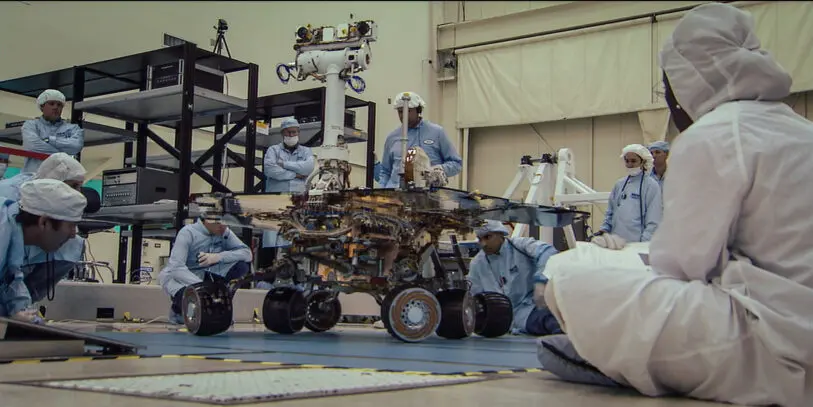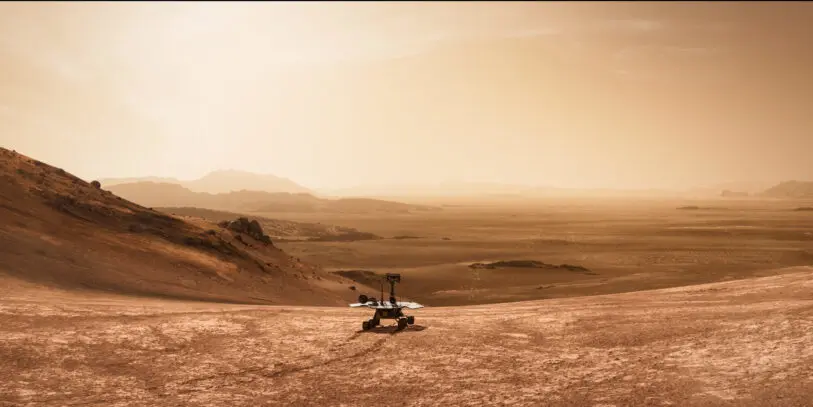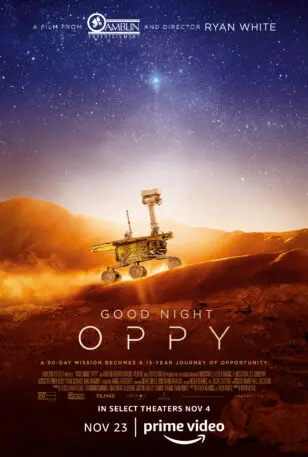Each generation of Mars rovers offers unique technological quirks: Pathfinder introduced the cushioned landing with inflated airbags; Phoenix, the anthropomorphized rover Twitter account; Curiosity, the far-out sky crane descent.
But Opportunity stands out as the Energizer Bunny of the bunch in its capacity to keep going . . . and going. The rover journeyed to Mars for an early 2004 landing along with a twin explorer named Spirit for 90-day missions. While Spirit lasted just over 6 years, Opportunity survived an astonishing 15, tracked a record 28 miles, and found some of the first definitive signs of past liquid water on the surface. The $400 million explorer lasted so long that it inspired successive generations of space scientists, some of whom were teens when it launched and grew up to work on it.
It is against this backdrop that Amazon Studios, Steven Spielberg’s Amblin Entertainment, and the Peter Berg-led Film 45, teamed for the documentary, Good Night Oppy, now in theaters and streaming November 23 on Amazon. (Its release serendipitously dovetails with the November 16 test launch of NASA’s Space Launch System rocket that may one day carry humans to Mars.)
“I like character-based films where you go on a journey,” says the film’s director, Ryan White. “A robot that was supposed to live for 90 days but survives for 15 years is a great logline. I’m such a space nerd from my young years when I wanted to be an astronaut; this was getting to relive those childhood dreams.”

Because of that, White was already well-acquainted with the public’s response to Opportunity’s dying breath in early 2019, when a science reporter tweeted a poetic interpretation of her last communication to Earth: “My battery is low and it’s getting dark.”
“Twitter went crazy over that message,” says White, who earned an Emmy nomination in 2014 with the HBO documentary The Case Against 8. “This rover was in trouble, alone on a planet, and it was this emotional gut-punch.”
White’s latest film—which recently earned five Critics Choice Awards, including top documentary—uses sentiment as entrée to the science through a whimsical blend of archival NASA footage; interviews with Jet Propulsion Laboratory (JPL) scientists and engineers who built the rover and managed the mission; music used to “wake” the rover each morning; and some particularly inventive CGI, courtesy of VFX powerhouse Industrial Light & Magic. The result weaves the mission’s engineering hurdles with the scientists’ emotional attachment to the robot.
“If it had been fully archival, it would’ve been a much less adventurous tale to not ever get to see Opportunity or Spirit and only see that world through their eyes,” says White. “I wanted to take the audience to Mars in a documentary way. I didn’t know that had never been done until I talked to Industrial Light & Magic. They said, `’We’ve never built Mars from scratch. We’ve built it around an actor in a desert in Utah, but never from the ground up.’”
Opportunity’s humanoid design certainly helped create a sense of character: two stereoscopic cameras atop a mast—like eyes—some five feet above the ground, and a robotic arm that unfolded to run tests on the Martian soil. But a dearth of action and considerable downtime posed some creative challenges.

“Narratively, the robots are not that exciting. They move so slowly, they don’t do much,” says White. Minus the fleeting excitement of the landing and dust storms, “Mars is pretty boring day to day. The way to keep it interesting was the human beings. They’re telling you the adventure.”
Initially, though, White worried he’d run into more Spocks than Kirks. “I had this preconceived notion that scientists and engineers would be very unemotional and academic, and somewhat detached,” he says with a laugh. “It ended up being the complete opposite; there are so many incredible storytellers who felt these unique attachments to the rover.”
Throughout the film, Opportunity’s team recounts mission milestones with terms like “proud parent” over her achievements to “forgetful” and “arthritic” when describing her decline. There was the young scientist who likened the weakening rover to her ailing grandmother and the engineers pleading with scientists to use the Opportunity’s remaining power for a selfie near the journey’s end.

Kobie Boykins, a senior mechanical engineer with JPL who helped design Opportunity’s solar arrays and is now chief engineer of the Europa Clipper, assigns Mars a kind of mystical partnership.

“We had a pretty good feeling that we would last on the surface for 270 days, but nobody was thinking we were going to make it past year 2, let alone 15,” says Boykins, who also appears in the film. “There were some unbelievable things that Mars did for us. Every so often, these dust storms came by and swept our solar arrays clean,” reinstating power output to just-landed levels. “It was just like, the life force we needed from Mars came and swept away the dust.”
Although White didn’t set out to make a social issues film, it’s hard to study Mars outside of Earth’s context. They’re both rocky planets, Mars is our closest planetary neighbor, and its now barren surface was once a wet world that might have harbored life. In the film, Boykins considers whether Earth awaits a similar fate if we’re not careful.
“One of the things that will come out of Spirit and Opportunity’s legacy is some of the answers as to why Mars had water, what happened to that water, and can we take the information to understand how that could happen to Earth and understand our part in that?” he says. “Are we doing something that could accelerate that change on Earth because that’s not something you recover from.”

It’s a timely conversation, especially considering the 2022 United Nations Climate Change Conference convening this month to discuss international efforts to counter global warming. Boykins further elaborates on the parallels: “It’s important we start to understand how our effect on our planet could lead to something catastrophic; to study our planetary neighbors in that particular perspective.”

It’s a sobering point in a film otherwise designed to celebrate a cooperative, persevering effort for the good of mankind. From the decade of failed proposals before mission approval, followed by ripped test parachutes and airbags, a solar flare disrupting the spacecraft electronics, the long silences waiting for rover responses, the wheels catching in the powdery surface, to the hint of possible life propelling subsequent Mars missions. It’s a window into the pressure and personal investment associated in the mission, and a love letter to the bonds formed in that teamwork.
“The film transforms me back to a place where I remember all those people I got to spend that time with,” says Boykins. “And then I think about the people I get to do that with in the next mission. Because it becomes a family.”
Recognize your brand’s excellence by applying to this year’s Brands That Matter Awards before the early-rate deadline, May 3.